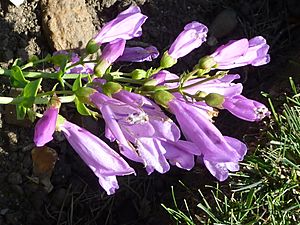Barrett's beardtongue facts for kids
Quick facts for kids Barrett's beardtongue |
|
|---|---|
 |
|
| Conservation status | |
| Scientific classification |
The Penstemon barrettiae, also known as Barrett's beardtongue or Barrett's penstemon, is a beautiful flowering plant. It belongs to the plantain family. This special plant is found only in a small area of the Pacific Northwest in North America. When a plant or animal is found only in one specific place, it is called endemic.
What Does It Look Like?
Barrett's beardtongue is a plant that grows back every year, which means it's a perennial. It can be a soft, green plant (an herb) or a small shrub. It usually grows between 20 to 40 centimeters (about 8 to 16 inches) tall.
This plant is smooth and doesn't have any hairs. Its leaves and flower clusters (called an inflorescence) feel a bit waxy. The leaves are blue-green and grow in pairs opposite each other on the stem. They are stiff and feel leathery. Their edges can be smooth or slightly jagged.
The leaf pairs on the stem can be up to 3.5 centimeters long. They have bases that wrap around the stem. The flowers are usually pink or light purple. They are shaped like tubes and are over 3 centimeters long. The opening of the flower is about 1 centimeter wide and has a "lipped" shape. You can see these lovely flowers blooming from April through June.
Where Does It Live?
Penstemon barrettiae loves to grow on cliffs and rocky areas. It prefers places where the soil is very thin. You might find it anchoring itself in cracks in rocks or in piles of broken rocks called talus.
This plant lives in a very specific region. It's found in southern Washington and northern Oregon. Key places where it grows include the Columbia River Gorge and the Klickitat River canyon.
Why It Needs Our Help
Even though it's tough, Barrett's beardtongue faces several challenges. Some people might try to illegally collect these plants, which is called poaching. Other threats come from things like road maintenance, chemicals used to kill weeds (herbicides), and digging for rocks (quarrying).
Logging (cutting down trees) and outdoor activities can also harm its habitat. Protecting these special places helps ensure this unique plant can continue to thrive.
Who Discovered It?
This plant was named after a woman named Almeta Hodge Barrett. She was the person who first found this species. She discovered it sometime before the year 1886.


